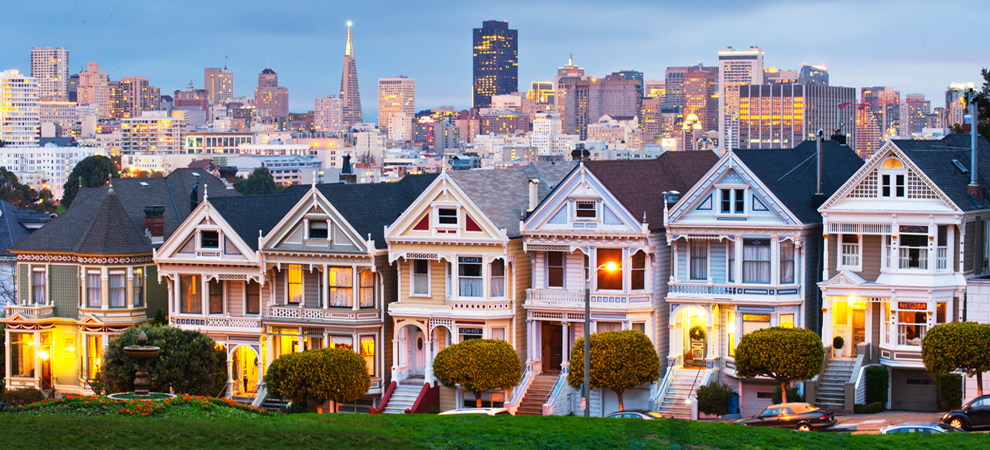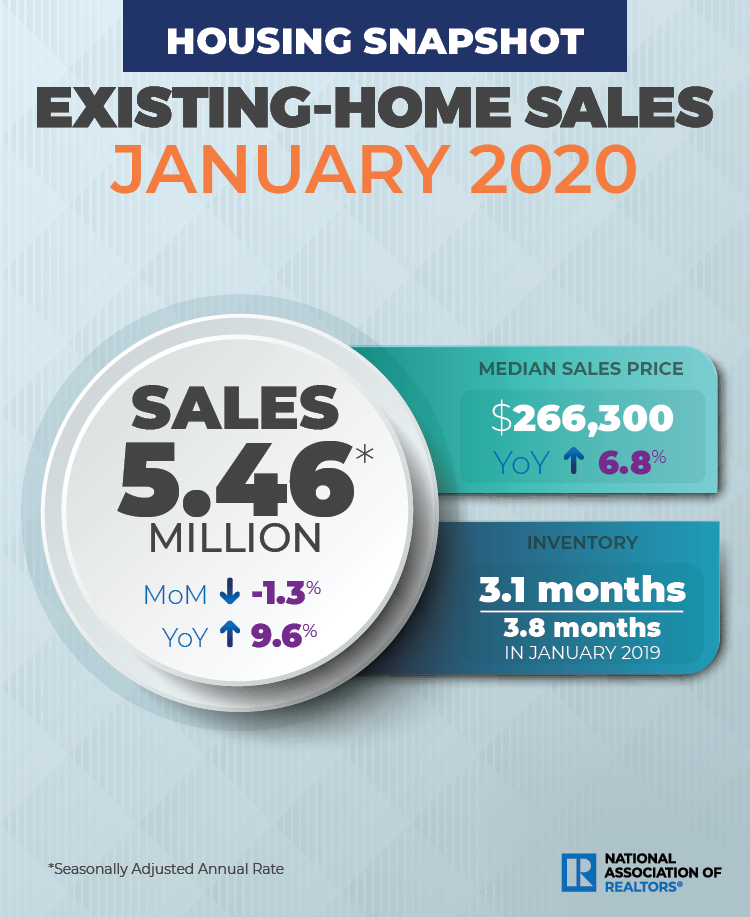The WPJ
THE WORLD PROPERTY JOURNALReal Estate Facts Not Fiction
Residential Real Estate News

U.S. Home Sales Dip in January
Residential News » San Francisco Edition | By Michael Gerrity | February 24, 2020 9:31 AM ET
According to the National Association of Realtors, existing-home sales in the U.S. declined in January 2020, continuing a fluctuating pattern of monthly increases and declines.
Significant declines in the West region dragged down nationwide numbers, with the other three major U.S. regions reporting marginal - or no - changes last month.
Total existing-home sales completed transactions that include single-family homes, townhomes, condominiums and co-ops, decreased 1.3% from December to a seasonally-adjusted annual rate of 5.46 million in January. However, for the second straight month, overall sales substantially increased year-over-year, up 9.6% from a year ago (4.98 million in January 2019).
 Lawrence Yun, NAR's chief economist, finds the outlook for 2020 home sales promising despite the drop in January. "Existing-home sales are off to a strong start at 5.46 million." Yun said. "The trend line for housing starts is increasing and showing steady improvement, which should ultimately lead to more home sales."
Lawrence Yun, NAR's chief economist, finds the outlook for 2020 home sales promising despite the drop in January. "Existing-home sales are off to a strong start at 5.46 million." Yun said. "The trend line for housing starts is increasing and showing steady improvement, which should ultimately lead to more home sales."
The median existing-home price for all housing types in January was $266,300, up 6.8% from January 2019 ($249,400), as prices increased in every region. December's price increase marks 95 straight months of year-over-year gains. "Mortgage rates have helped with affordability, but it is supply conditions that are driving price growth," Yun said.
Total housing inventory at the end of January totaled 1.42 million units, up 2.2% from December, but down 10.7% from one year ago (1.59 million). The housing inventory level for January is the lowest level since 1999. Unsold inventory sits at a 3.1-month supply at the current sales pace, up from the 3.0-month figure recorded in December and down from the 3.8-month figure recorded in January 2019.
NAR's latest quarterly report found that an overwhelming majority of metro areas experienced price gains while witnessing very minor increases in inventory in the final quarter of 2019.
Properties typically remained on the market for 43 days in January, seasonally up from 41 days in December, but down from 49 days in January 2019. Forty-two percent of homes sold in January 2020 were on the market for less than a month.
First-time buyers were responsible for 32% of sales in January, up from 31% in December and up from 29% in January 2019. NAR's 2019 Profile of Home Buyers and Sellers - released in late 2019 - revealed that the annual share of first-time buyers was 33%.
"It is good to see first-time buyers slowly stepping into the market," Yun said. "The rise in the homeownership rate among the younger adults, under 35, and minority households means an increasing number of Americans can build wealth by owning real estate. Still, in order to further expand opportunities, significantly more inventory and home construction are needed at the affordable price points."
Individual investors or second-home buyers, who account for many cash sales, purchased 17% of homes in January, equal to December 2019 and up slightly from 16% in January 2019.All-cash sales accounted for 21% of transactions in January, up from 20% in December but down from 23% in January 2019.
Distressed sales - foreclosures and short sales - represented 2% of sales in January, unchanged from December 2019 and down from January 2019.
Realtor.com's Market Hotness Index, measuring time-on-the-market data and listing views per property, revealed that the hottest metro areas in January were Fort Wayne, Ind.; San Francisco-Oakland-Hayward, Calif.; Sacramento-Roseville-Arden-Arcade, Calif.; Lafayette-West Lafayette, Ind.; and San Jose-Sunnyvale-Santa Clara, Calif.
According to Freddie Mac, the average commitment rate for a 30-year, conventional, fixed-rate mortgage decreased to 3.62% in January, down from 3.72% in December. One year ago, the commitment rate was 4.46%.
"We are hopeful and also confident that home sales will improve this year," said NAR President Vince Malta, broker at Malta & Co., Inc., in San Francisco, Calif. "NAR has and will continue to do its part in the industry, reiterating the social and economic benefits of homeownership and advancing conversations surrounding housing affordability concerns."
Single-family and Condo/Co-op Sales
Single-family home sales sat at a seasonally-adjusted annual rate of 4.85 million in January, down from 4.91 million in December, but up 9.7% from a year ago. The median existing single-family home price was $268,600 in January 2020, up 6.9% from January 2019.
Existing condominium and co-op sales were recorded at a seasonally adjusted annual rate of 610,000 units in January, down 1.6% from December but 8.9% higher than a year ago. The median existing condo price was $248,100 in January, an increase of 5.7% from a year ago.
Regional Breakdown
Compared to last month, January sales increased in the Midwest and the South, while year-over-year sales are up in each of the four regions. Median home prices in all regions increased from one year ago, with the Northeast region showing the strongest price gain.
January 2020 existing-home sales in the Northeast saw no movement, recording an annual rate of 730,000, which is up 7.4% from a year ago. The median price in the Northeast was $312,100, up 11.5% from January 2019.
Existing-home sales increased 2.4% in the Midwest to an annual rate of 1.29 million, which is up 8.4% from a year ago. The median price in the Midwest was $200,000, a 5.4% increase from last January.
Existing-home sales in the South grew 0.4% to an annual rate of 2.38 million in January, up 11.7% from a year ago. The median price in the South was $229,900, a 6.3% increase from this time last year.
Existing-home sales in the West fell 9.4% to an annual rate of 1.06 million in January, an 8.2% increase from a year ago. The median price in the West was $393,800, up 5.2% from January 2019.
Significant declines in the West region dragged down nationwide numbers, with the other three major U.S. regions reporting marginal - or no - changes last month.
Total existing-home sales completed transactions that include single-family homes, townhomes, condominiums and co-ops, decreased 1.3% from December to a seasonally-adjusted annual rate of 5.46 million in January. However, for the second straight month, overall sales substantially increased year-over-year, up 9.6% from a year ago (4.98 million in January 2019).

Lawrence Yun
The median existing-home price for all housing types in January was $266,300, up 6.8% from January 2019 ($249,400), as prices increased in every region. December's price increase marks 95 straight months of year-over-year gains. "Mortgage rates have helped with affordability, but it is supply conditions that are driving price growth," Yun said.
Total housing inventory at the end of January totaled 1.42 million units, up 2.2% from December, but down 10.7% from one year ago (1.59 million). The housing inventory level for January is the lowest level since 1999. Unsold inventory sits at a 3.1-month supply at the current sales pace, up from the 3.0-month figure recorded in December and down from the 3.8-month figure recorded in January 2019.
NAR's latest quarterly report found that an overwhelming majority of metro areas experienced price gains while witnessing very minor increases in inventory in the final quarter of 2019.
Properties typically remained on the market for 43 days in January, seasonally up from 41 days in December, but down from 49 days in January 2019. Forty-two percent of homes sold in January 2020 were on the market for less than a month.
First-time buyers were responsible for 32% of sales in January, up from 31% in December and up from 29% in January 2019. NAR's 2019 Profile of Home Buyers and Sellers - released in late 2019 - revealed that the annual share of first-time buyers was 33%.
"It is good to see first-time buyers slowly stepping into the market," Yun said. "The rise in the homeownership rate among the younger adults, under 35, and minority households means an increasing number of Americans can build wealth by owning real estate. Still, in order to further expand opportunities, significantly more inventory and home construction are needed at the affordable price points."
Individual investors or second-home buyers, who account for many cash sales, purchased 17% of homes in January, equal to December 2019 and up slightly from 16% in January 2019.All-cash sales accounted for 21% of transactions in January, up from 20% in December but down from 23% in January 2019.
Distressed sales - foreclosures and short sales - represented 2% of sales in January, unchanged from December 2019 and down from January 2019.
Realtor.com's Market Hotness Index, measuring time-on-the-market data and listing views per property, revealed that the hottest metro areas in January were Fort Wayne, Ind.; San Francisco-Oakland-Hayward, Calif.; Sacramento-Roseville-Arden-Arcade, Calif.; Lafayette-West Lafayette, Ind.; and San Jose-Sunnyvale-Santa Clara, Calif.
According to Freddie Mac, the average commitment rate for a 30-year, conventional, fixed-rate mortgage decreased to 3.62% in January, down from 3.72% in December. One year ago, the commitment rate was 4.46%.
"We are hopeful and also confident that home sales will improve this year," said NAR President Vince Malta, broker at Malta & Co., Inc., in San Francisco, Calif. "NAR has and will continue to do its part in the industry, reiterating the social and economic benefits of homeownership and advancing conversations surrounding housing affordability concerns."
Single-family and Condo/Co-op Sales
Single-family home sales sat at a seasonally-adjusted annual rate of 4.85 million in January, down from 4.91 million in December, but up 9.7% from a year ago. The median existing single-family home price was $268,600 in January 2020, up 6.9% from January 2019.
Existing condominium and co-op sales were recorded at a seasonally adjusted annual rate of 610,000 units in January, down 1.6% from December but 8.9% higher than a year ago. The median existing condo price was $248,100 in January, an increase of 5.7% from a year ago.
Regional Breakdown
Compared to last month, January sales increased in the Midwest and the South, while year-over-year sales are up in each of the four regions. Median home prices in all regions increased from one year ago, with the Northeast region showing the strongest price gain.
January 2020 existing-home sales in the Northeast saw no movement, recording an annual rate of 730,000, which is up 7.4% from a year ago. The median price in the Northeast was $312,100, up 11.5% from January 2019.
Existing-home sales increased 2.4% in the Midwest to an annual rate of 1.29 million, which is up 8.4% from a year ago. The median price in the Midwest was $200,000, a 5.4% increase from last January.
Existing-home sales in the South grew 0.4% to an annual rate of 2.38 million in January, up 11.7% from a year ago. The median price in the South was $229,900, a 6.3% increase from this time last year.
Existing-home sales in the West fell 9.4% to an annual rate of 1.06 million in January, an 8.2% increase from a year ago. The median price in the West was $393,800, up 5.2% from January 2019.
Sign Up Free | The WPJ Weekly Newsletter
Relevant real estate news.
Actionable market intelligence.
Right to your inbox every week.
Real Estate Listings Showcase
Related News Stories
Residential Real Estate Headlines
- Las Vegas Area Home Prices Uptick 4.3 Percent Annually in March
- Single-Family Rent Growth in U.S. Trends Upward in 2025
- U.S. Mortgage Rates Tick Down Post Trump Tariffs Commencement
- President Trump's 'Liberation Day' Tariffs Potential Impact on the U.S. Housing and Mortgage Markets
- Baby Boomers Biggest Cohort of U.S. Home Buyers in 2025 as Millennials Decline
- U.S. Monthly Housing Payments Hit Record High in 2025
- U.S. Pending Home Sales Uptick in February
- Global Prime Residential Rent Slowdown Continued in Late 2024
- Ireland Home Price Inflation Hits 8 Year High in Early 2025
- Existing Home Sales in America Uptick in February
- Great Miami Area Residential Sales Decline 15 Percent Annually in February
- Mortgage Rates Uptick in Mid-March, Ending 9-Week Decline in U.S.
- World Property Ventures Builds the Future of Real Estate with New Funding Round
- U.S. Builder Sentiment Declines Amid Economic Uncertainty and Rising Costs
- Black Homeownership Rates in U.S. Enjoy Largest Annual Increase of All Racial Groups
- Wealthy Renters Are Taking Over More of the U.S. Rental Market
- If U.S. Congress Does Not Extend NFIP Soon, Thousands of Daily Home Closings Impacted
- U.S. Mortgage Applications Spike 11 Percent in Early March
- Greater Palm Beach Area Residential Sales Rise in Early 2025
- New Apartments in U.S. Are Leasing at Slowest Pace on Record
- U.S. Mortgage Rates Drop to 4 Month Low in March
- Overall U.S. Mortgage Delinquency Rates Dip in December
- New Tariffs on Canada, Mexico to Impact U.S. Homebuilder Input Costs
- Monaco's Property Market: A Tale of Two Cities
- U.S. Home Purchase Cancellations Surge, 1 in 7 Sales Getting Canceled
- U.S. Pending Home Sales Hit Historic Low in Early 2025
- Greater Miami Area Residential Sales Dip in January
- Governor DeSantis Supports Ending Property Taxes in Florida
- WPV Aims to Become the Berkshire Hathaway of Real Estate Tech
- U.S. Home Sales Slump Continues in January
- Average Americans Spend 38 Percent of Monthly Income on Mortgage Payments
- Switzerland's Safe-Haven Appeal Grows with World's Wealthy Homebuyers
- U.S. Builder Confidence Rapidly Declines in February
- Las Vegas Home Sales Rise 6.7 Percent Annually in January, Condo Sales Dip
- Homebuyer Demand in America Drops to 5-Year Low in Early 2025
- Ownership More Affordable Than Renting in Most U.S. Markets
- The World's First Global Listings Service Launches, Called a GLS
- Home Prices Continue to Rise in 89 Percent of U.S. Metros in Late 2024
- Global Luxury Residential Prices Showed Gradual Improvement in Late 2024
- U.S. Construction Hiring Rate Drops to Lowest Levels in 5 Years
Reader Poll
Marketplace Links
This website uses cookies to improve user experience. By using our website you consent in accordance with our Cookie Policy. Read More






